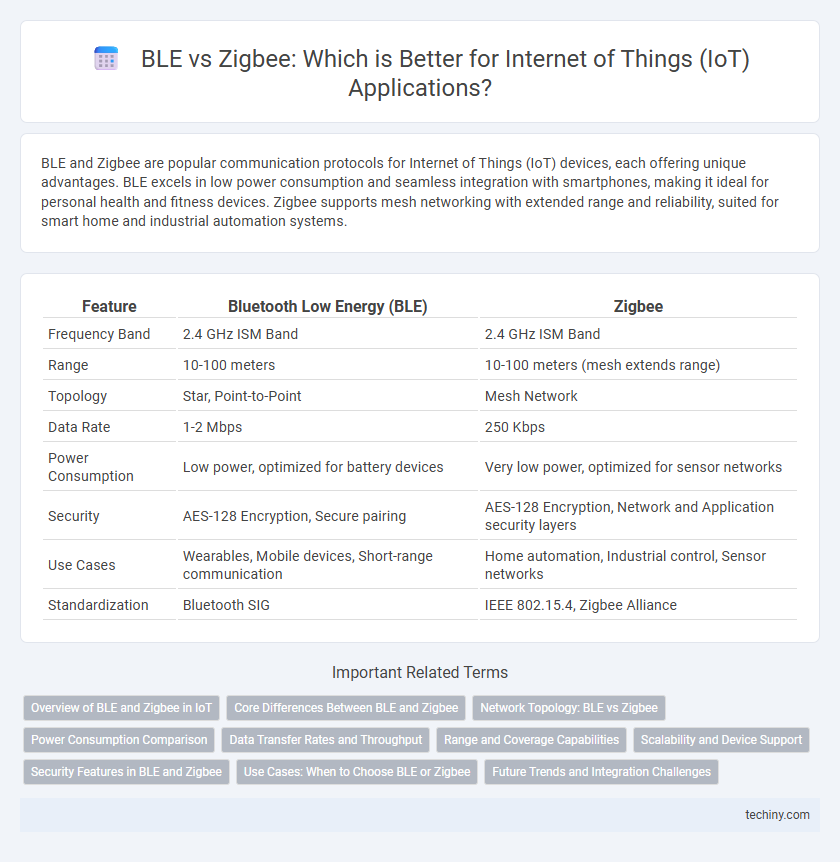BLE and Zigbee are popular communication protocols for Internet of Things (IoT) devices, each offering unique advantages. BLE excels in low power consumption and seamless integration with smartphones, making it ideal for personal health and fitness devices. Zigbee supports mesh networking with extended range and reliability, suited for smart home and industrial automation systems.
Table of Comparison
| Feature | Bluetooth Low Energy (BLE) | Zigbee |
|---|---|---|
| Frequency Band | 2.4 GHz ISM Band | 2.4 GHz ISM Band |
| Range | 10-100 meters | 10-100 meters (mesh extends range) |
| Topology | Star, Point-to-Point | Mesh Network |
| Data Rate | 1-2 Mbps | 250 Kbps |
| Power Consumption | Low power, optimized for battery devices | Very low power, optimized for sensor networks |
| Security | AES-128 Encryption, Secure pairing | AES-128 Encryption, Network and Application security layers |
| Use Cases | Wearables, Mobile devices, Short-range communication | Home automation, Industrial control, Sensor networks |
| Standardization | Bluetooth SIG | IEEE 802.15.4, Zigbee Alliance |
Overview of BLE and Zigbee in IoT
Bluetooth Low Energy (BLE) and Zigbee are leading wireless communication protocols in the Internet of Things (IoT) ecosystem, each designed for low-power, short-range connectivity. BLE is widely favored for its compatibility with smartphones and consumer devices, offering data rates up to 2 Mbps and enhanced pairing efficiency. Zigbee excels in mesh networking capabilities, supporting thousands of nodes with low latency and robust security, making it ideal for smart home and industrial automation applications.
Core Differences Between BLE and Zigbee
BLE (Bluetooth Low Energy) excels in short-range, low-power wireless communication primarily for personal devices, offering rapid data transfer rates up to 2 Mbps and efficient battery life for wearables and smartphones. Zigbee is designed for mesh networking in home automation and industrial IoT, supporting hundreds of nodes with low power consumption and reliable device-to-device communication over distances up to 100 meters. BLE operates on a star topology ideal for point-to-point connections, while Zigbee's mesh topology enhances network scalability and resilience in complex IoT environments.
Network Topology: BLE vs Zigbee
BLE primarily supports star and mesh topologies with efficient device-to-device communication ideal for short-range applications, while Zigbee excels in mesh topologies enabling robust, self-healing networks suitable for extensive IoT deployments. Zigbee's mesh network allows thousands of nodes to interconnect and extend range through multi-hop routing, making it highly scalable for smart home and industrial environments. BLE mesh, though newer and less mature, provides low latency and lower power consumption optimized for mobile and wearable IoT devices.
Power Consumption Comparison
Bluetooth Low Energy (BLE) typically consumes less power than Zigbee, making it ideal for battery-operated devices requiring infrequent data transmission. BLE's adaptive frequency hopping and efficient sleep modes reduce energy usage, allowing devices to run for years on small coin-cell batteries. Zigbee, while supporting mesh networking and robust security, generally demands higher power for continuous network participation and routing tasks.
Data Transfer Rates and Throughput
BLE (Bluetooth Low Energy) offers data transfer rates up to 2 Mbps with optimized power consumption, making it suitable for short bursts of data transmission in IoT applications. Zigbee provides lower data rates, typically around 250 Kbps, but excels in mesh network throughput and scalability for large sensor deployments. The choice between BLE and Zigbee depends on balancing data rate needs with network size and energy efficiency requirements.
Range and Coverage Capabilities
Bluetooth Low Energy (BLE) typically offers a shorter range of up to 100 meters, making it suitable for personal area networks and close-proximity device communication. Zigbee supports longer range capabilities, extending up to 300 meters in outdoor environments, thanks to its mesh networking architecture that enhances coverage and reliability across larger IoT deployments. BLE is preferred for low-power, short-distance interactions, while Zigbee excels in expansive smart home and industrial sensor networks requiring robust coverage.
Scalability and Device Support
BLE supports up to 50,000 devices in a single network, enabling large-scale IoT deployments with low power consumption ideal for personal area networks. Zigbee, designed specifically for mesh networking, easily scales to over 65,000 devices, providing robust device support for industrial and home automation systems. Zigbee's network topology allows efficient communication among numerous nodes, while BLE excels in environments requiring high device density with minimal energy use.
Security Features in BLE and Zigbee
BLE employs AES-128 encryption with adaptive frequency hopping to secure data transmission, minimizing interference and eavesdropping risks in IoT devices. Zigbee integrates AES-128 encryption at the network, transport, and application layers, providing layered security through key establishment and device authentication. Both protocols support secure key management, but Zigbee's hierarchical security model offers enhanced protection for complex IoT networks.
Use Cases: When to Choose BLE or Zigbee
BLE excels in short-range, low-power applications such as fitness trackers, smart home devices, and proximity-based services where direct smartphone interaction is common. Zigbee is ideal for large-scale, mesh network environments like industrial automation, smart lighting systems, and building management due to its robust network reliability and extended range. Choosing BLE suits scenarios requiring seamless integration with mobile devices, while Zigbee is preferred for dense device networks demanding efficient communication and scalability.
Future Trends and Integration Challenges
BLE's future trends emphasize enhanced energy efficiency and expanded mesh networking capabilities to support large-scale IoT deployments, while Zigbee focuses on improved security protocols and interoperability with emerging smart home ecosystems. Integration challenges include BLE's limited range and potential interference in dense environments, contrasted with Zigbee's complexity in device pairing and network scalability. Both technologies face the ongoing need to balance power consumption, latency, and seamless integration with diverse IoT platforms and cloud services.
BLE vs Zigbee Infographic

 techiny.com
techiny.com